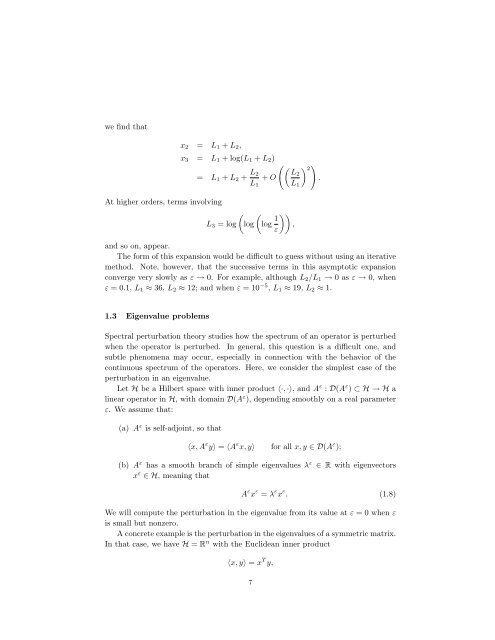Asymptotic Analysis and Singular Perturbation Theory
Asymptotic Analysis and Singular Perturbation Theory
Asymptotic Analysis and Singular Perturbation Theory
Create successful ePaper yourself
Turn your PDF publications into a flip-book with our unique Google optimized e-Paper software.
we find that<br />
x2 = L1 + L2,<br />
At higher orders, terms involving<br />
x3 = L1 + log(L1 + L2)<br />
= L1 + L2 + L2<br />
L2 <br />
2<br />
+ O<br />
.<br />
L3 = log<br />
L1<br />
L1<br />
<br />
log log 1<br />
<br />
,<br />
ε<br />
<strong>and</strong> so on, appear.<br />
The form of this expansion would be difficult to guess without using an iterative<br />
method. Note, however, that the successive terms in this asymptotic expansion<br />
converge very slowly as ε → 0. For example, although L2/L1 → 0 as ε → 0, when<br />
ε = 0.1, L1 ≈ 36, L2 ≈ 12; <strong>and</strong> when ε = 10 −5 , L1 ≈ 19, L2 ≈ 1.<br />
1.3 Eigenvalue problems<br />
Spectral perturbation theory studies how the spectrum of an operator is perturbed<br />
when the operator is perturbed. In general, this question is a difficult one, <strong>and</strong><br />
subtle phenomena may occur, especially in connection with the behavior of the<br />
continuous spectrum of the operators. Here, we consider the simplest case of the<br />
perturbation in an eigenvalue.<br />
Let H be a Hilbert space with inner product 〈·, ·〉, <strong>and</strong> A ε : D(A ε ) ⊂ H → H a<br />
linear operator in H, with domain D(A ε ), depending smoothly on a real parameter<br />
ε. We assume that:<br />
(a) A ε is self-adjoint, so that<br />
〈x, A ε y〉 = 〈A ε x, y〉 for all x, y ∈ D(A ε );<br />
(b) A ε has a smooth branch of simple eigenvalues λ ε ∈ R with eigenvectors<br />
x ε ∈ H, meaning that<br />
A ε x ε = λ ε x ε . (1.8)<br />
We will compute the perturbation in the eigenvalue from its value at ε = 0 when ε<br />
is small but nonzero.<br />
A concrete example is the perturbation in the eigenvalues of a symmetric matrix.<br />
In that case, we have H = R n with the Euclidean inner product<br />
〈x, y〉 = x T y,<br />
7
















